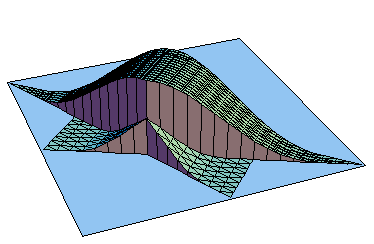Highly idealised model for TCP rate control mechanism
This Java applet demonstrates the behaviour n highly idealised TCP sources sharing the capacity of the same bottleneck link. In other words, we are trying to model the so-called Additive Increase and Multiplicative Decrease (AIMD) rate control mechanism. Normally, each source increases its sending rate by a small amount per unit time corresponding to the additive increase phase of the AIMD rate control scheme. Then, as soon as the total transmission rate of the sources attains the capacity of the bottleneck link, a negative acknowledgement (NAK) signal is sent to a randomly chosen source (i.e., a packet is dropped). In response to that the particular source will reduce its sending rate to half, i.e., the multiplicative decrease in AIMD scheme.
The area in the middle of the simulator illustrates the evolution of the sending rates as a function of time. Traffic volumes corresponding to the different sources are indicated by different colours (red,blue,...). The arrows pointing downwards correspond to the moments of time when the particular source receives a NAK and thus decreases its sending rate to half.
Some details:
Note that:- The behaviour of a single TCP flow sharing a common bottleneck link with other TCP flows is not independent of the other flows (a common assumption in TCP modelling). That is, after a certain source has reduced its sending rate according to the AIMD scheme the other flows are more unlikely to experience a packet drop (or NAK) immediately. This, otherwise very elementary model, captures this correlation between different TCP flows more correctly.
- In the model the source which rate is adjusted is chosen randomly with the probabilities proportional to the current sending rates of the sources.
- The approach taken is a so-called fluid flow approach where instead of modelling actual packets we consider a fluid flow with continuously varying "sending" rate.
- The system is highly idealised, e.g., the RTT is assumed to be a constant
- For a single source the system reduces to a totally deterministic system
- The model can be analysed by considering the embedded Markov process at the points where the rate adjustment occurs (see Refs. [1-2]). For example, the joint pdf of transmission rates of two flows at an arbitrary point of time is illustrated in Fig. 1.
References:
- Esa Hyytiä and Peder J. Emstad, A model for TCP congestion control capturing the correlations in times between the congestion events, in 2nd EuroNGI Conference on Next Generation Internet Design and Engineering (NGI 2006), 2006, València, Spain.
- Esa Hyytiä, Erling Austreim and Peder J. Emstad, Complementary analysis and numerical results for an elementary fluid flow model of TCP, in Fourth International Working Conference on Performance Modelling and Evaluation of Heterogeneous Networks (HET-NETs'06), 2006, Ilkley, West Yorkshire, U.K.
- Jim Kurose and Keith Ross, Computer Networking: a top-down approach featuring the Internet, Addison-Wesley, 2001.
- Transmission Control Protocol article from Wikipedia
| Esa Hyytiä, created 2006, last update 15th of September 2006. |
|
